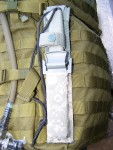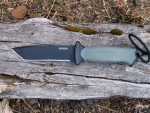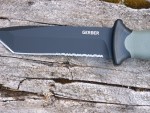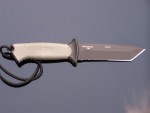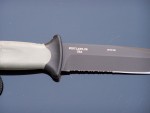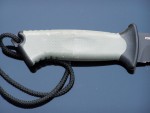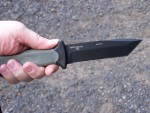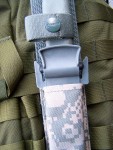For a lot of years, Gerber knives was a major player in the cutlery field. However, some years back, they fell out of favor with a lot of consumers, and their line-up of knives really shrank quite a bit. Honestly, it’s been at least 15 years or longer since Gerber sent me any knives for articles. I don’t know if it was a change of shifts or powers-that-be, but they stopped sending me knives to write about. That’s okay; there are more than enough knife companies that do send me samples for testing and articles. One of the best fixed blade knives that Gerber made, in my humble opinion, was their BMF. It was a huge 9-inch fixed blade, Bowie-style knife, perfect for camp chores or survival purposes. It’s no longer made, and I regret not having one in my meager knife collection.
Today, Gerber is on the rise once again, and many of their knives are being produced overseas, which is something I thought I’d never see from Gerber, as they were making all their knives in the USA at their plant in Portland, OR. However, with the global economy and global market, you either jump on the wagon train or you are left behind and will more than likely go out of business. Today, Gerber has a huge selection of knives and other gear to choose from. Keep in mind that you usually get what you pay for when it comes to knives made overseas. If you want a cheap $2 knife, they will make that for you. If you want a high-end $500 knife, they will produce that for you as well. So, don’t let “made in China” or “made in Taiwan” scare you off.
Last summer, I was cruising the Amazon website for something when an ad for the Gerber Prodigy fixed blade Tanto knife kept popping up for some reason. You know how those “cookies” work on computers; if you once look at something, cookies picks this up and ads will pop-up for weeks with that product. I was more than a little intrigued with the Gerber Prodigy that I kept seeing, so much so that I finally ordered one. The price was right, too. Gerber advertises this knife on their website for $73, and I got my sample for $37.97 with free shipping from Amazon.com. Wait, that can’t be? Yep, it was $37.97 with free shipping!
Surely, this Gerber Prodigy wasn’t going to be up to my high expectations in a good survival blade, but it wasn’t that much money to lose if the knife wasn’t all that good. A close look at the Prodigy shows that it has a 4.75-inch Tanto blade; for deep penetration, it’s hard to beat this style of blade. The blade is made out of 420HC, which is a fairly common stainless steel and a good steel, too. The handle is made out of some sort of green synthetic rubbery-type of material that is called FG504, and the sheath is really sweet, too. It not only locks the Prodigy into it with a loud “click” from the design of the locking portion of the sheath, it also has a strap to further lock the knife in place. This hummer is jump proof, for those of you in the military airborne. The sheath also allows you to attach it to your belt, with an added strap that wraps around your leg, but you can also secure it to military MOLLE gear. (The sheath that came with my sample is the military ACU camo color.)
The Prodigy came in that pain in the rear blister packaging, and I needed a good sharp knife to cut the packaging open. It was obviously designed for sale in the big box stores, where it can be hung on a counter or display rack, making it easy to see but very hard to shoplift without removing the knife from the blister pack. On top of it all, the Prodigy is made in the USA! Huh? A knife of this quality and at this price is made in America? That couldn’t be! However, I checked it out on the Gerber website, and sure enough the knife is made in America. I also elected the partially-serrated blade that is serrated for approximately one-third of the blade. A serrated blade is great for cutting rope, especially wet rope or poly rope, and rips right through it. It’s nice for survival purposes, too.
The blade is blackened. I don’t think it is TiNi coated but just a black, tough powder coating for that subdued look that is great for military use. The cross guard is also black, and it appears to be made out of aluminum. It is non-magnetic. Then we have the FG504 hard rubber handle. The pummel is pointed with a lanyard hole on the end of it, and a piece of 550 para cord was attached, which is nice, real nice! The rubberized handle also has some friction grooves molded into it for a very secure grip on the knife in any weather conditions. That’s another great touch, if you ask me.
To be sure, Gerber makes this style of fixed blade knife in several different blade styles, as well as with several slightly different colors and other variations. Some are called a “military” knife; however, they are all basically the same knife. So if you don’t like the Prodigy, though I don’t know why you wouldn’t, you can easily find a similar style from Gerber. There is actually quite a selection to pick from. I’m thinking about getting another one with a different color and/or style of blade for the money.
Over the course of a couple weeks, during our super-hot summer in Western Oregon, I put the Prodigy through its paces, slicing and dicing all manner of material. The Prodigy came hair-popping sharp from the package, too. It could easily slice through a blackberry vine, and if you’ve never tried to cut this material you’d be surprised how super-tough it is to cut through with a single swipe of the blade. I also easily sliced through poly rope and hemp rope was no challenge. Much to the dismay of my German Shepherds, who love to tear apart boxes that UPS and FedEx bring me, that chore was reserved for the Prodigy. I cut through a lot of boxes, slicing them until there wasn’t nothing much left, but my “boys” still had plenty to fight over and chew apart when I was done.
I did some knife throwing, never expecting the Prodigy to stick in a tree, and it never did. However, the point of this part of the testing was to see just how tough the knife was. Yeah, the blackened blade got scuffed up a bit, as did the rubberized handle, but it was only cosmetic. The knife wasn’t damaged. During all of my testing, the knife never needed to have the blade touched-up. It stayed sharp, even during some kitchen chores like cutting meat and veggies.
In my knife testing, I do not test to destruction. Any knife, no matter who makes it, can be broken. Any knife! I’ve received e-mails from some SurvivalBlog readers over the years asking me why I don’t try to break knifes I get for testing. Well, as I said, any knife can be broken. Nothing is U.S. Marine-proof, if you ask me. However, if you use a knife as a cutting/chopping tool, it will serve its intended purpose as a tool. If you use it as a pry bar, you will break the blade eventually; count on it. The guys at the gun shop I haunt are always using their pocket knives as a screw driver, and sure enough they are always walking around with a folding knife with the tip broken off. It’s so much easier to carry some sort of multi-tool that has screw drivers built in, instead of breaking the tip off of a folding knife and then get mad when the maker doesn’t warranty the knife for this sort of abuse!
As I sit here and type this article, I’ve already convinced myself to get at least one more Prodigy just to have around. My current sample is attached to my Bug Out Bag on the outside using the MOLLE attaching straps. This way, I know I’ll have a fixed blade knife with me when the time comes to actually Bug Out. I have “that” much confidence in this blade that it will serve my survival needs when I might have to bug out.
Be sure to check out this knife on the Amazon.com website and find the best deal you can on it, even Walmart carries it on their website as well but for a bit more money than I paid for my sample. This is one tough knife for the money, and I highly recommend it. And, remember, this wasn’t a sample; I paid for it out of my own pocket. Way to go, Gerber!
– Senior Product Review Editor, Pat Cascio










